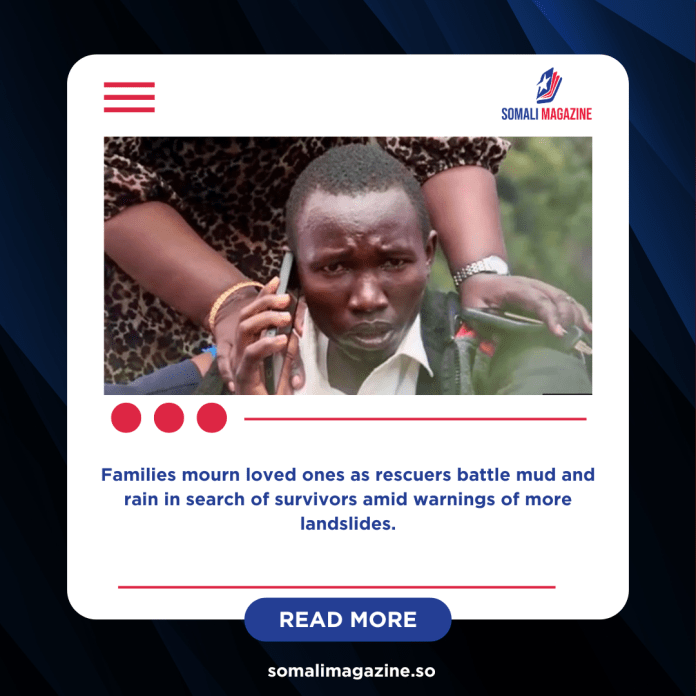Facebook Twitter (X) Instagram Somali Magazine - People's Magazine
More than 40 people have died after a series of landslides hit the mountainous border region between Kenya and Uganda last week. Heavy rains triggered the deadly slides, burying homes and cutting off roads, as communities on both sides of the border continue to search for missing loved ones.
In Kenya’s Kaptul village, 30-year-old Felix Kemboi is mourning the loss of seven relatives, including his grandmother, sisters, and uncle. “I lost a grandmother, a maternal aunt, an uncle, two sisters, a family friend and a cousin,” he told the BBC, his voice filled with grief. He said he could barely find words to describe the pain of losing so many family members at once.
The Kenyan government has warned that more landslides could occur as heavy rainfall continues across several regions. Interior Minister Kipchumba Murkomen said that areas around the Kerio Valley are particularly at risk and urged residents to stay alert for signs of shifting ground. Authorities are relocating families living in vulnerable zones to safer, higher ground.
According to Kenya’s education ministry, 14 schoolchildren were among the dozens killed when two massive mudslides swept through parts of the Great Rift Valley. The tragedy has left entire communities in mourning, as emergency teams continue to search for missing people using limited equipment.
Across the border in Uganda, survivors have shared horrifying experiences of the night the disaster struck. Helda Narunga Masai, from Kween village, said her home was destroyed when the mudslide came down the mountain. “We were sleeping at night when we heard a huge sound,” she recalled. “Our neighbours shouted, ‘Wake up! The mountain is coming.’ My niece and brother died.” She is now staying with a neighbour after losing everything.
In nearby Kapchorwa district, a woman and three children from the same family also lost their lives. Uganda’s Red Cross reports that at least 18 people have died in the country’s east, with around 20 others still missing in Kapchorwa, Bukwo, and Kween districts. Volunteers and Red Cross staff have joined local rescue teams, who are digging through thick mud using basic tools to recover bodies and search for survivors.
Local leader Mande David Kapcheronge told the BBC that the rescue teams are facing tough conditions, with mudslides blocking roads and making it hard to reach affected communities. “We are using whatever tools we can find to dig through the mud,” he said. “It’s heartbreaking.”
Experts have long warned that many of the affected regions in both Uganda and Kenya are prone to landslides. The steep terrain, deforestation, and heavy rainfall make the area especially vulnerable. In 2010, a massive landslide in Uganda’s Bududa district killed about 300 people, one of the deadliest disasters in the country’s history. Despite repeated warnings, many people continue to build homes on unstable hillsides due to limited land and economic hardship.
In Uganda, the government has announced that it will compensate affected families, providing 5 million shillings (around $1,300) to each bereaved family and 1 million shillings to survivors. Search and recovery operations, however, remain slow as access roads have been destroyed or blocked by mud. The Kenyan government has not yet announced any compensation plans.
As both countries continue to deal with the aftermath of the disaster, residents are calling for stronger disaster preparedness measures and safer housing programs in high-risk areas. For now, grieving families like Felix Kemboi’s are left with the painful task of rebuilding their lives amid the mud and loss.

